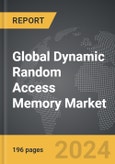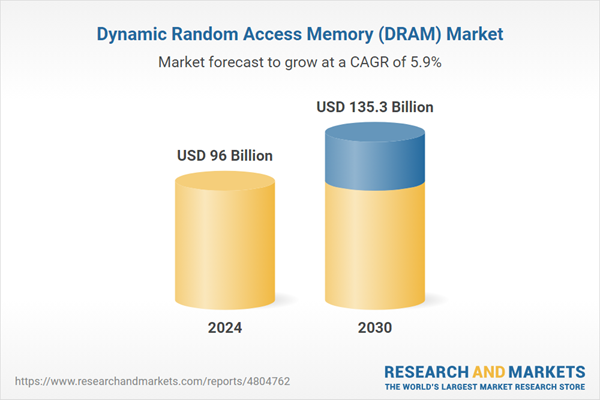The global market for Dynamic Random Access Memory (DRAM) was valued at US$96.0 Billion in 2024 and is projected to reach US$135.3 Billion by 2030, growing at a CAGR of 5.9% from 2024 to 2030. This comprehensive report provides an in-depth analysis of market trends, drivers, and forecasts, helping you make informed business decisions.
Global Dynamic Random Access Memory (DRAM) Market - Key Trends and Drivers Summarized
What Is Dynamic Random Access Memory (DRAM) and How Does It Function in Modern Computing?
Dynamic Random Access Memory (DRAM) is a type of semiconductor memory widely used in electronic devices where speed and volatility are key components, such as in personal computers, workstations, and servers. Unlike its counterpart, static RAM (SRAM), DRAM stores each bit of data in a separate tiny capacitor within an integrated circuit, which must be periodically refreshed with an electronic charge to maintain data. This refreshing requirement is why DRAM is referred to as 'dynamic.' Although it is slower and less stable than SRAM, DRAM compensates with its ability to pack a larger amount of memory into a smaller physical space and at a lower cost per bit, making it an ideal solution for applications requiring large amounts of RAM. Its primary role in devices is to hold the data required by the system processor for short-term use, allowing faster access than retrieving data from a hard disk or SSD, significantly speeding up processing and responsiveness.What Are the Technological Advancements Impacting DRAM Development?
Technological advancements have continuously shaped the evolution of DRAM, enhancing both its capacity and performance to meet the demands of increasingly sophisticated computing systems. Key innovations include the development of Double Data Rate (DDR) technology, which improves data transfer rates by transferring data on both the rising and falling edges of the clock signal, effectively doubling the memory chip's data throughput. Subsequent iterations, from DDR2 to DDR5, have progressively enhanced bandwidth and reduced power consumption, critical for high-performance computing environments. Another significant advancement is the shift towards smaller fabrication nodes, which allows more memory cells to be packed into the same physical space, increasing density and decreasing cost-per-bit. Manufacturers have also started integrating 3D stacking technology, which layers multiple DRAM chips vertically, significantly boosting data transfer speeds and reducing latency, essential for applications like artificial intelligence and machine learning.How Is DRAM Utilized Across Different Industries?
DRAM's capability to provide rapid data access makes it invaluable across various sectors. In consumer electronics, it is essential for enhancing the multitasking capabilities of devices such as smartphones and tablets, allowing them to run multiple applications simultaneously without a hitch. In the computing industry, DRAM supports complex, resource-intensive software applications, facilitating faster operations in data centers and cloud computing platforms. This is particularly vital in handling big data analytics and supporting the immense processing needs of enterprise-grade servers. Additionally, DRAM is critical in gaming, where it helps deliver high-resolution, seamless graphics and real-time processing for a better user experience. The automotive industry also benefits from DRAM, particularly with the advancement towards autonomous driving systems, where rapid data processing is crucial for real-time decision-making.What Drives the Growth in the DRAM Market?
The growth in the DRAM market is driven by several factors, including the ever-increasing demand for higher performance computing systems, proliferation of mobile devices, and advancements in technologies such as cloud computing and the Internet of Things (IoT). As devices become more connected and data-intensive, the need for fast and efficient memory solutions to process and store data is paramount. The expansion of AI and machine learning across various sectors - from healthcare diagnostics to automated financial systems - further propels the demand for DRAM, as these technologies rely heavily on high-speed data processing. Additionally, the rise in online gaming and digital media consumption pushes the need for more robust memory systems, fueling further development and innovation in the DRAM sector. Moreover, as more businesses migrate to cloud-based platforms, the need for data centers with massive, fast-access memory capabilities increases, directly impacting the growth of the DRAM market. Together, these technological shifts and consumer behaviors drive the continuous evolution and expansion of the DRAM industry, ensuring its pivotal role in the future of digital infrastructure.Report Scope
The report analyzes the Dynamic Random Access Memory (DRAM) market, presented in terms of market value (US$ Thousand). The analysis covers the key segments and geographic regions outlined below.Segments
Application (Handheld Devices, Computers, Consumer Electronics, Networking, Other Applications).Geographic Regions/Countries
World; United States; Canada; Japan; China; Europe (France; Germany; Italy; United Kingdom; Spain; Russia; and Rest of Europe); Asia-Pacific (Australia; India; South Korea; and Rest of Asia-Pacific); Latin America (Argentina; Brazil; Mexico; and Rest of Latin America); Middle East (Iran; Israel; Saudi Arabia; United Arab Emirates; and Rest of Middle East); and Africa.Key Insights:
- Market Growth: Understand the significant growth trajectory of the Handheld Devices Application segment, which is expected to reach US$49.0 Billion by 2030 with a CAGR of a 7.3%. The Computers Application segment is also set to grow at 5.9% CAGR over the analysis period.
- Regional Analysis: Gain insights into the U.S. market, valued at $25.0 Billion in 2024, and China, forecasted to grow at an impressive 9.1% CAGR to reach $31.8 Billion by 2030. Discover growth trends in other key regions, including Japan, Canada, Germany, and the Asia-Pacific.
Report Features:
- Comprehensive Market Data: Independent analysis of annual sales and market forecasts in US$ Million from 2024 to 2030.
- In-Depth Regional Analysis: Detailed insights into key markets, including the U.S., China, Japan, Canada, Europe, Asia-Pacific, Latin America, Middle East, and Africa.
- Company Profiles: Coverage of major players such as Kingston Technology Co., Inc., Micron Technology, Inc., Nanya Technology Corporation, Samsung Electronics Co., Ltd., SK Hynix, Inc. and more.
- Complimentary Updates: Receive free report updates for one year to keep you informed of the latest market developments.
Why You Should Buy This Report:
- Detailed Market Analysis: Access a thorough analysis of the Global Dynamic Random Access Memory (DRAM) Market, covering all major geographic regions and market segments.
- Competitive Insights: Get an overview of the competitive landscape, including the market presence of major players across different geographies.
- Future Trends and Drivers: Understand the key trends and drivers shaping the future of the Global Dynamic Random Access Memory (DRAM) Market.
- Actionable Insights: Benefit from actionable insights that can help you identify new revenue opportunities and make strategic business decisions.
Key Questions Answered:
- How is the Global Dynamic Random Access Memory (DRAM) Market expected to evolve by 2030?
- What are the main drivers and restraints affecting the market?
- Which market segments will grow the most over the forecast period?
- How will market shares for different regions and segments change by 2030?
- Who are the leading players in the market, and what are their prospects?
Some of the 46 major companies featured in this Dynamic Random Access Memory (DRAM) market report include:
- Kingston Technology Co., Inc.
- Micron Technology, Inc.
- Nanya Technology Corporation
- Samsung Electronics Co., Ltd.
- SK Hynix, Inc.
- Transcend Information, Inc.
- Winbond Electronics Corporation
Table of Contents
I. METHODOLOGYII. EXECUTIVE SUMMARY2. FOCUS ON SELECT PLAYERSIII. MARKET ANALYSISSOUTH KOREAREST OF ASIA-PACIFICARGENTINABRAZILMEXICOREST OF LATIN AMERICAIRANISRAELSAUDI ARABIAUNITED ARAB EMIRATESREST OF MIDDLE EASTIV. COMPETITION
1. MARKET OVERVIEW
3. MARKET TRENDS & DRIVERS
4. GLOBAL MARKET PERSPECTIVE
UNITED STATES
CANADA
JAPAN
CHINA
EUROPE
FRANCE
GERMANY
ITALY
UNITED KINGDOM
SPAIN
RUSSIA
REST OF EUROPE
ASIA-PACIFIC
AUSTRALIA
INDIA
LATIN AMERICA
MIDDLE EAST
AFRICA
Companies Mentioned (Partial List)
A selection of companies mentioned in this report includes, but is not limited to:
- Kingston Technology Co., Inc.
- Micron Technology, Inc.
- Nanya Technology Corporation
- Samsung Electronics Co., Ltd.
- SK Hynix, Inc.
- Transcend Information, Inc.
- Winbond Electronics Corporation
Table Information
| Report Attribute | Details |
|---|---|
| No. of Pages | 196 |
| Published | March 2025 |
| Forecast Period | 2024 - 2030 |
| Estimated Market Value ( USD | $ 96 Billion |
| Forecasted Market Value ( USD | $ 135.3 Billion |
| Compound Annual Growth Rate | 5.9% |
| Regions Covered | Global |









